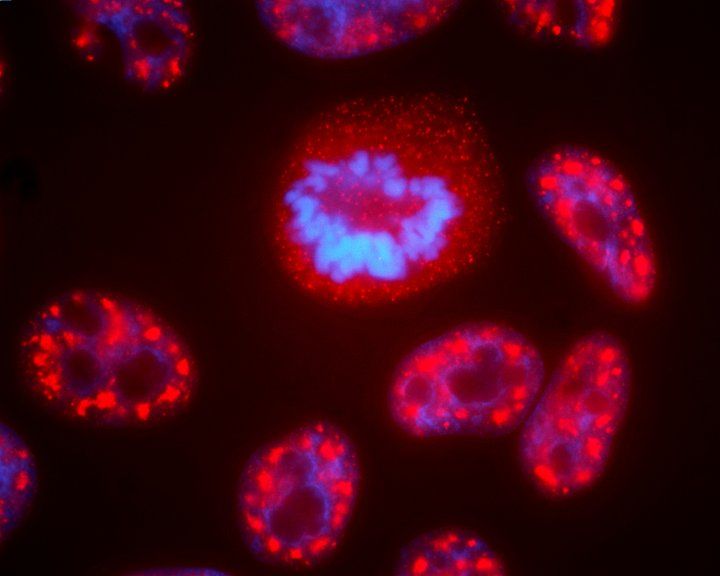How Cells Multitask: The Magic of Molecular Switches

Image by Steve Mabon,Tom Misteli, NCI Center for Cancer Research, National Cancer Institute, National Institutes of Health
Proteins grease the wheels of nearly all the functions carried out in our cells. They often interact in a cascading fashion – one protein signals another to turn on, which then activates another, and so on. The proteins at the key decision points in these networks, called regulatory proteins, can be thought of as molecular switches, creating a subtle control system that allows the complex systems within a cell to respond to changes in the environment.
A single switch, however, has a lot to do. These molecules are agile multitaskers, managing to regulate a large number of different biological processes simultaneously. Recently, researchers at UC San Francisco’s Quantitative Biosciences Institute (QBI) have glimpsed how that feat is achieved, and the findings may shed light on how disease mutations operate, offering new ways to target these switches when they malfunction, and thereby prevent illness.
“We made new discoveries relating to a fundamental part of regulatory biology,” said Tanja Kortemme, PhD, a professor of bioengineering and co-senior author of the study in Nature. “This is a really new insight that changes our understanding of these systems.”
To see how a single protein can act on many others at once, Kortemme looked at a molecular switch called Gsp1, which plays an essential role in regulating cell growth and transport of molecules within the cell.
Kortemme, who studies proteins, teamed up with co-senior author Nevan Krogan, PhD, director of QBI, who looks at the networks that arise when those protein molecules interact. Their combined specialties allowed them to look at protein networks on multiple scales, revealing the overall impact of the system’s individual components – in this case observing how a mutation in DNA can result in a mutated protein that may stymie many different pathways in the cell.
Krogan said that bringing together the researchers’ varied expertise drove some serendipitous findings. “Science moves so much more quickly when scientists from different disciplines work together,” he said. “The philosophy of collaboration manifested these unexpected discoveries.”
Finally, Evidence Backing a Decades-Old Theory
Activity in a biological system can be thought of as arising from genes, which carry the instructions for proteins. Some of these proteins – the ones that act as molecular switches – regulate cell functions, which in turn dictate the organization of tissues and organs and, ultimately, the characteristics of an organism.
Kortemme and her team took the novel approach of looking at the impact of the Gsp1 molecular switch at different scales in this pathway from gene to organism. They wanted to see how a mutation at the gene level might impact not only the switch’s ability to regulate other proteins, but also how that would affect functions further down the line, ultimately impacting different characteristics.
We could find not only new biological mechanisms, but also a new class of drugs that regulate these switch molecules in a very selective way.
Tanja Kortemme, UCSF Professor of Bioengineering
They found that introducing a single mutation into the protein at the genetic level could have complex and dramatic consequences on the cell’s biology. Some systems, like cell division, responded to how quickly the switch turned off. Other systems were affected by how quickly the switch turned on. Still others were affected by the rate of both on and off actions.
“What might seem like a simple switch – just a single molecule – actually operates like three separate switches when we look at it on the level of the cell,” said Tina Perica, PhD, a postdoctoral scholar in Kortemme’s lab, who, along with graduate student Christopher Mathy, are first authors of the study and now leads her own group at the University of Zürich.
This scaling impact was initially theorized in the 1980s, and Kortemme’s study offers the first experimental evidence supporting it, Kortemme said. “These changes seem small quantitatively, but they get amplified in the cellular level because of the regulatory power of the switch,” she explained.
Regulating the Regulators
Even the proteins that regulate other proteins need to be modulated. In many instances in a cell, protein function is fine-tuned when another molecule binds to the protein and changes its shape. Kortemme’s team found that these molecular switches are no exception.
The team discovered four sites on the Gsp1 switch where this shape-changing can occur. These areas, said Kortemme, may be targets for future drug development, and she believes that many other central molecular switch proteins may have such areas.
Kortemme sees promise in using the multi-scale approach to reveal similar sites in other regulator proteins. “We could find not only new biological mechanisms, but also a new class of drugs that regulate these switch molecules in a very selective way.”
Funding: This project was supported by a grant from the National institutes of Health (R01-GM117189) as well Tina Perica’s Sir Henry Wellcome Postdoctoral Fellowship (101614/Z/13/Z) and Chris Mathy’s UCSF Discovery Fellowship.
About QBI: The Quantitative Biosciences Institute (QBI) fosters collaborations across the biomedical and the physical sciences, seeking quantitative methods to address pressing problems in biology and biomedicine. Motivated by problems of human disease, QBI is committed to investigating fundamental biological mechanisms, because ultimately solutions to many diseases have been revealed by unexpected discoveries in the basic sciences.